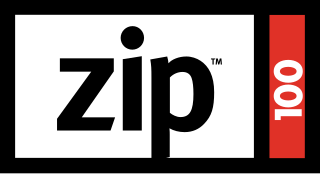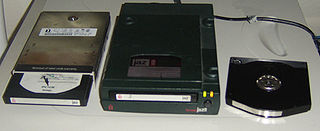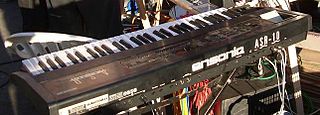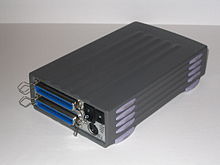
Parallel ATA (PATA), originally AT Attachment, also known as IDE, is a standard interface designed for IBM PC-compatible computers. It was first developed by Western Digital and Compaq in 1986 for compatible hard drives and CD or DVD drives. The connection is used for storage devices such as hard disk drives, floppy disk drives, optical disc drives, and tape drives in computers.

A hard disk drive (HDD), hard disk, hard drive, or fixed disk, is an electro-mechanical data storage device that stores and retrieves digital data using magnetic storage with one or more rigid rapidly rotating platters coated with magnetic material. The platters are paired with magnetic heads, usually arranged on a moving actuator arm, which read and write data to the platter surfaces. Data is accessed in a random-access manner, meaning that individual blocks of data can be stored and retrieved in any order. HDDs are a type of non-volatile storage, retaining stored data when powered off. Modern HDDs are typically in the form of a small rectangular box.

Small Computer System Interface is a set of standards for physically connecting and transferring data between computers and peripheral devices, best known for its use with storage devices such as hard disk drives. SCSI was introduced in the 1980s and has seen widespread use on servers and high-end workstations, with new SCSI standards being published as recently as SAS-4 in 2017.

The ST-506 and ST-412 were early hard disk drive products introduced by Seagate in 1980 and 1981 respectively, that later became construed as hard disk drive interfaces: the ST-506 disk interface and the ST-412 disk interface. Compared to the ST-506 precursor, the ST-412 implemented a refinement to the seek speed, and increased the drive capacity from 5 MB to 10 MB, but was otherwise highly similar.

The Zip drive is a removable floppy disk storage system that was introduced by Iomega in late 1994. Considered medium-to-high-capacity at the time of its release, Zip disks were originally launched with capacities of 100 MB, then 250 MB, and finally 750 MB.

In computing, an optical disc drive is a disc drive that uses laser light or electromagnetic waves within or near the visible light spectrum as part of the process of reading or writing data to or from optical discs. Some drives can only read from certain discs, but recent drives can both read and record, also called burners or writers. Compact discs, DVDs, and Blu-ray discs are common types of optical media which can be read and recorded by such drives.

The Bernoulli Box is a high-capacity removable floppy disk storage system that is Iomega's first widely known product. It was released in 1982.

A magneto-optical drive is a kind of optical disc drive capable of writing and rewriting data upon a magneto-optical disc. 130 mm (5.25 in) and 90 mm (3.5 in) discs were the most common sizes. In 1983, just a year after the introduction of the compact disc, Kees Schouhamer Immink and Joseph Braat presented the first experiments with erasable magneto-optical compact discs during the 73rd AES Convention in Eindhoven. The technology was introduced commercially in 1985. Although optical, they normally appear as hard disk drives to an operating system and can be formatted with any file system. Magneto-optical drives were common in some countries, such as Japan, but have fallen into disuse.
SyQuest Technology, Inc. (Nasdaq: SYQT) was an early entrant into the hard disk drive market for personal computers. The company was founded on January 27, 1982 by Syed Iftikar who had been a founder of Seagate, along with Ben Alaimo, Bill Krajewski, Anil Nigam and George Toldi. Its earliest products were the SQ306R, a 5 MB 3.9" (100 mm) cartridge disk drive and associated Q-Pak cartridge for IBM XT compatibles. Subsequently a non-removable medium version was announced, the SQ306F.

The Atari Falcon030, released in 1992, is the final personal computer from Atari Corporation. A high-end model of the Atari ST line, the machine is based on a Motorola 68030 CPU and a Motorola 56001 digital signal processor, which distinguishes it from most other microcomputers of the era. It includes a new VIDEL programmable graphics system which greatly improves graphics capabilities.

Floptical refers to a type of floppy disk drive that combines magnetic and optical technologies to store data on media similar to standard 3+1⁄2-inch floppy disks. The name is a portmanteau of the words "floppy" and "optical". It refers specifically to one brand of drive and disk system, but is also used more generically to refer to any system using similar techniques.

REV is a removable hard disk storage system from Iomega.

The Jaz drive is a removable hard disk storage system sold by the Iomega company from 1995 to 2002.

The Commodore 64 home computer used various external peripherals. Due to the backwards compatibility of the Commodore 128, most peripherals would also work on that system. There is also some compatibility with the VIC-20 and Commodore PET.

The Orb Drive is a 3.5-inch removable hard-disk drive introduced by Castlewood Systems in 1999. Its original capacity was 2.2 GB. A later version of the drive was introduced in 2001 with a capacity of 5.7 GB. Manufacturing of this product ceased in 2004.
The SparQ drive is a removable-disk hard drive made by SyQuest Technology. It was introduced in 1997, available as an internal or external version. The internal version utilized an IDE interface, and the external version used a parallel port. The disk can store 1 GB of data. As a removable-disk hard drive, it contains a solid hard disk platter on which the data is stored.

The Ensoniq ASR-10 was a sampling keyboard produced by Ensoniq between 1992 and 1998. The ASR-10 was a follow-up product to the very popular Ensoniq EPS and Ensoniq EPS-16+ performance samplers, and was also available with a piano style weighted keyboard (ASR-88) and a rackmount version (ASR-10R). At the time, the machine was one of the most powerful samplers available.

The Seagate Barracuda is a series of hard disk drives and later solid state drives produced by Seagate Technology that was first introduced in 1993.

The Apple Tape Backup 40SC is an external, SCSI-interfaced, 1⁄4-inch (6.35 mm) QIC, mini-cartridge tape drive. It was first introduced by Apple Inc. in 1987 and discontinued in 1994. The drive came bundled with Retrospect backup software. The drive is also compatible with the tape software included with A/UX.
Hard disk drives are accessed over one of a number of bus types, including parallel ATA, Serial ATA (SATA), SCSI, Serial Attached SCSI (SAS), and Fibre Channel. Bridge circuitry is sometimes used to connect hard disk drives to buses with which they cannot communicate natively, such as IEEE 1394, USB, SCSI, NVMe and Thunderbolt.


















